IUPAC ID Gallium nitride Density 6.15 g/cm³ Melting point 2,500 °C Appearance yellow powder | Formula GaN Molar mass 83.73 g/mol Soluble in Water | |
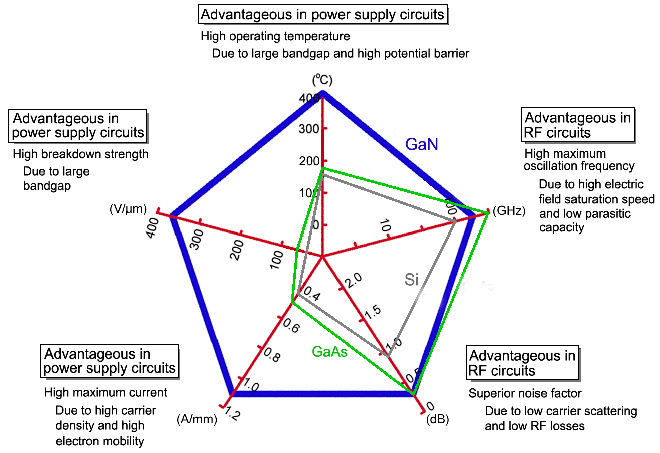 | ||
Related compounds | ||
Gallium nitride
Gallium nitride (GaN) is a binary III/V direct bandgap semiconductor commonly used in light-emitting diodes since the 1990s. The compound is a very hard material that has a Wurtzite crystal structure. Its wide band gap of 3.4 eV affords it special properties for applications in optoelectronic, high-power and high-frequency devices. For example, GaN is the substrate which makes violet (405 nm) laser diodes possible, without use of nonlinear optical frequency-doubling.
Contents
- Gallium nitride
- Physical properties
- Developments
- LEDs
- High frequency high voltage high temperature high efficiency
- Nanoscale
- Bulk substrates
- Molecular beam epitaxy
- Safety
- References
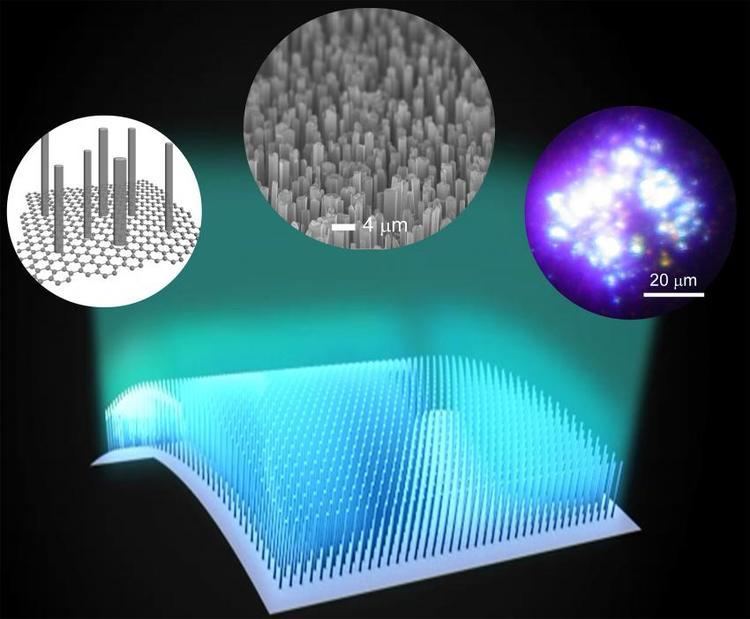
Its sensitivity to ionizing radiation is low (like other group III nitrides), making it a suitable material for solar cell arrays for satellites. Military and space applications could also benefit as devices have shown stability in radiation environments. Because GaN transistors can operate at much higher temperatures and work at much higher voltages than gallium arsenide (GaAs) transistors, they make ideal power amplifiers at microwave frequencies.
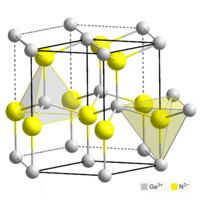
Physical properties
GaN is a very hard (12±2 GPa), mechanically stable wide bandgap semiconductor material with high heat capacity and thermal conductivity. In its pure form it resists cracking and can be deposited in thin film on sapphire or silicon carbide, despite the mismatch in their lattice constants. GaN can be doped with silicon (Si) or with oxygen to n-type and with magnesium (Mg) to p-type; however, the Si and Mg atoms change the way the GaN crystals grow, introducing tensile stresses and making them brittle. Gallium nitride compounds also tend to have a high dislocation density, on the order of a hundred million to ten billion defects per square centimeter.
Developments
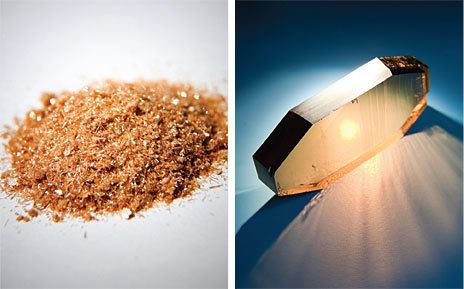
GaN with a high crystalline quality can be obtained by depositing a buffer layer at low temperatures. Such high-quality GaN led to the discovery of p-type GaN, p-n junction blue/UV-LEDs and room-temperature stimulated emission (essential for laser action). This has led to the commercialization of high-performance blue LEDs and long-lifetime violet-laser diodes, and to the development of nitride-based devices such as UV detectors and high-speed field-effect transistors.
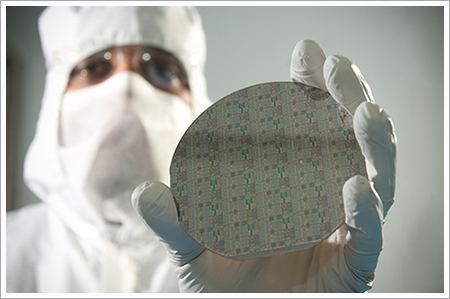
High-brightness GaN light-emitting diodes (LEDs) completed the range of primary colors, and made applications such as daylight visible full-color LED displays, white LEDs and blue laser devices possible. The first GaN-based high-brightness LEDs used a thin film of GaN deposited via Metal-Organic Vapour Phase Epitaxy (MOVPE) on sapphire. Other substrates used are zinc oxide, with lattice constant mismatch of only 2% and silicon carbide (SiC). Group III nitride semiconductors are, in general, recognized as one of the most promising semiconductor families for fabricating optical devices in the visible short-wavelength and UV region.
The very high breakdown voltages, high electron mobility and saturation velocity of GaN has also made it an ideal candidate for high-power and high-temperature microwave applications, as evidenced by its high Johnson's figure of merit. Potential markets for high-power/high-frequency devices based on GaN include microwave radio-frequency power amplifiers (such as those used in high-speed wireless data transmission) and high-voltage switching devices for power grids. A potential mass-market application for GaN-based RF transistors is as the microwave source for microwave ovens, replacing the magnetrons currently used. The large band gap means that the performance of GaN transistors is maintained up to higher temperatures (~400 °C) than silicon transistors(~150 °C), because it lessens the effects of thermal generation of charge carriers that are inherent to any semiconductor. The first gallium nitride metal semiconductor field-effect transistors (GaN MESFET) were experimentally demonstrated in 1993 and they are being actively developed.
In 2010 the first enhancement-mode gallium nitride transistors became generally available. These devices were designed to replace power MOSFETs in applications where switching speed or power conversion efficiency is critical. These transistors, also called eGaN FETs, are built by growing a thin layer of GaN on top of a standard silicon wafer. This allows the eGaN FETs to maintain costs similar to silicon power MOSFETs but with the superior electrical performance of GaN.
LEDs
GaN-based violet laser diodes are used to read Blu-ray Discs. When doped with a suitable transition metal such as manganese, GaN is a promising spintronics material (magnetic semiconductors). The mixture of GaN with In (InGaN) or Al (AlGaN) with a band gap dependent on ratio of In or Al to GaN allows the manufacture of light-emitting diodes (LEDs) with colors that can go from red to ultra-violet.
High frequency, high voltage, high temperature, high efficiency
GaN HEMTs have been offered commercially since 2006, and have found immediate use in various wireless infrastructure applications due to their high efficiency and high voltage operation. Second generation technology with shorter gate lengths will be addressing higher frequency telecom and aerospace applications.
GaN based MOSFET and MESFET transistors also offer advantages including lower loss in high power electronics, especially in automotive and electric car applications.
They are also utilized in military electronics such as active electronically scanned array radars.
GaN-based electronics (not pure GaN) has the potential to drastically cut energy consumption, not only in consumer applications but even for power transmission utilities. MIT spinout Cambridge Electronics Inc's claim their transistors have at most one-tenth the resistance of such silicon-based transistors. This allows for much higher energy efficiency, and orders-of-magnitude faster switching frequency. This has huge implications not only for energy usage of power electronics systems, but their physical size and stability. Unlike silicon transistors which switch off due to power surges, GaN transistors are typically depletion mode (i.e. on / resistive when the gate-source voltage is zero), however the company along with US government and university assistance developed GaN transistors via materials engineering to also be available as enhancement mode ("normally off") devices, just as silicon based transistors.
Nanoscale
GaN nanotubes are proposed for applications in nanoscale electronics, optoelectronics and biochemical-sensing applications.
Bulk substrates
GaN crystals can be grown from a molten Na/Ga melt held under 100 atmospheres of pressure of N2 at 750 °C. As Ga will not react with N2 below 1000 °C, the powder must be made from something more reactive, usually in one of the following ways:
2 Ga + 2 NH3 → 2 GaN + 3 H2 Ga2O3 + 2 NH3 → 2 GaN + 3 H2OMolecular beam epitaxy
Commercially, GaN crystals can be grown using molecular beam epitaxy. This process can be further modified to reduce dislocation densities. First, an ion beam is applied to the growth surface in order to create nanoscale roughness. Then, the surface is polished. This process takes place in a vacuum.
Safety
GaN dust is an irritant to skin, eyes and lungs. The environment, health and safety aspects of gallium nitride sources (such as trimethylgallium and ammonia) and industrial hygiene monitoring studies of MOVPE sources have been reported recently in a review.
Bulk GaN is non-toxic and biocompatible, and therefore may be used in the electrodes and electronics of implants in living organisms.
